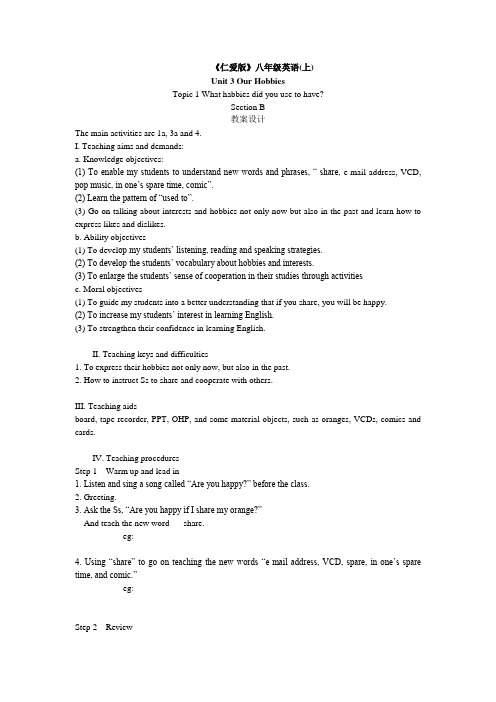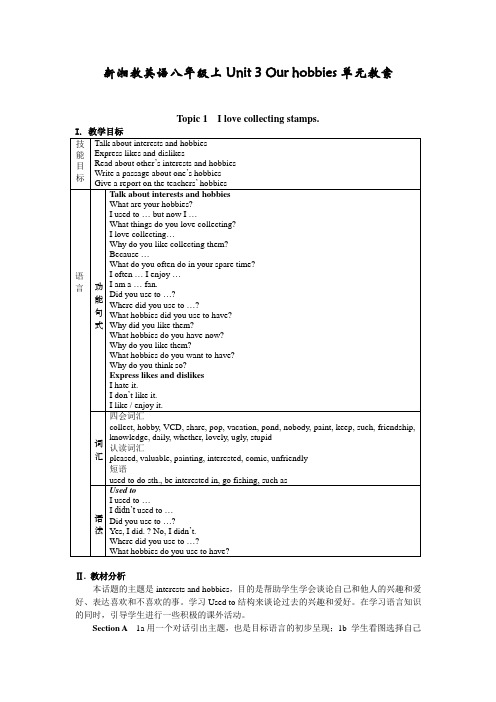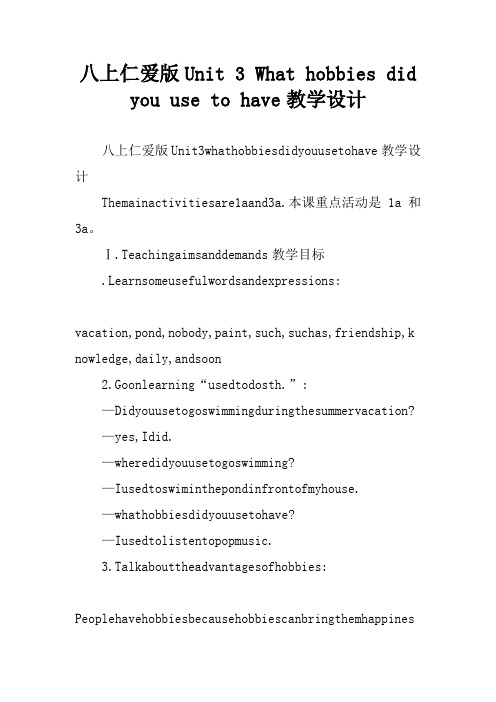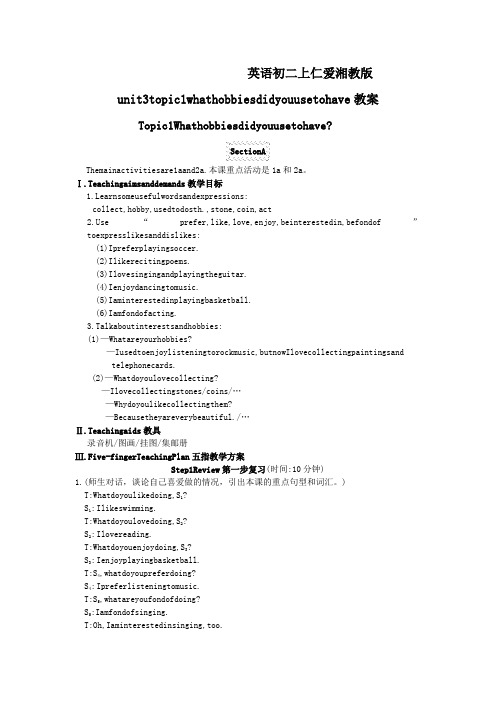八上仁爱版Unit3Whathobbiesdidyouusetohave教学设计
- 格式:docx
- 大小:16.78 KB
- 文档页数:7

仁爱版英语八年级上册Unit 3 Topic 1 《What’s your hobby》教学设计一. 教材分析仁爱版英语八年级上册Unit 3 Topic 1《What’s your hobby》主要介绍了关于人们兴趣爱好的一些话题。
通过本节课的学习,学生能够掌握关于兴趣爱好的一些基本词汇和句型,并能够运用所学知识进行简单的日常交流。
本节课的内容与学生的生活紧密相连,有利于激发学生的学习兴趣和积极参与课堂活动的欲望。
二. 学情分析八年级的学生已经具备了一定的英语基础,能够听懂并运用一些基本的英语句型进行交流。
但是,学生在口语表达方面还存在一定的困难,需要教师的引导和鼓励。
此外,学生对于新的学习内容容易产生兴趣,但同时也容易注意力不集中,需要教师通过丰富多样的教学活动来吸引学生的注意力。
三. 教学目标1.知识目标:学生能够掌握关于兴趣爱好的一些基本词汇和句型,如“What’s your hobby?” “I like playing basketball.”等。
2.能力目标:学生能够运用所学知识进行简单的日常交流,能够介绍自己的兴趣爱好并询问他人的兴趣爱好。
3.情感目标:通过本节课的学习,学生能够培养对英语学习的兴趣,增强学习的自信心。
四. 教学重难点1.重点:学生能够掌握关于兴趣爱好的一些基本词汇和句型。
2.难点:学生能够运用所学知识进行简单的日常交流,能够介绍自己的兴趣爱好并询问他人的兴趣爱好。
五. 教学方法1.任务型教学法:通过设计各种任务,让学生在完成任务的过程中运用所学知识,提高学生的实际运用能力。
2.情境教学法:通过创设各种情境,让学生在真实的环境中进行英语交流,提高学生的口语表达能力。
3.激励评价法:在教学过程中,教师要注重对学生的积极评价,激发学生的学习兴趣和自信心。
六. 教学准备1.教学课件:制作相关的教学课件,包括图片、视频等素材,以便于教学展示。
2.教学卡片:制作相关的词汇卡片,用于课堂操练和巩固环节。

《仁爱版》八年级英语(上)Unit 3 Our HobbiesTopic 1 What habbies did you use to have?Section B教案设计The main activities are 1a, 3a and 4.I. Teaching aims and demands:a. Knowledge objectives:(1) To enable my students to understand new words and phrases, “ share, e-mail address, VCD, pop music, in one’s spare time, comic”.(2) Learn the pattern of “used to”.(3) Go on talking about interests and hobbies not only now but also in the past and learn how to express likes and dislikes.b. Ability objectives(1) To devel op my students’ listening, reading and speaking strategies.(2) To develop the students’ vocabulary about hobbies and interests.(3) To enlarge the students’ sense of cooperation in their studies through activitiesc. Moral objectives(1) To guide my students into a better understanding that if you share, you will be happy.(2) To increase my students’ interest in learning English.(3) To strengthen their confidence in learning English.II. Teaching keys and difficulties1. To express their hobbies not only now, but also in the past.2. How to instruct Ss to share and cooperate with others.III. Teaching aidsboard, tape recorder, PPT, OHP, and some material objects, such as oranges, VCDs, comics and cards.IV. Teaching proceduresStep 1 Warm up and lead in1. Listen and sing a song called “Are you happy?” before the class.2. Greeting.3. Ask the Ss, “Are you happy if I share my orange?”And teach the new word-----share.eg:4. Using “share” to go on teaching the new words“e-mail address, VCD, spare, in one’s spare time, and comic.”eg:Step 2 Review1. Share hobbies with the Ss.a. Tell the Ss my hobbies, then encourage the Ss to tell me theirsb. While talking, use the brainstorming to review what hobbies we have learnt.eg:Step 3 (part 2) Look, listen and match1. Tell the Ss we have 8 more friends to share their hobbies with us, but we need to match their hobbies with the right English phrases.2. Let the Ss look and match3. Have the Ss listen to the tape recorder and number the sentences with the pictures.eg:Step 4 (1a) Look, listen and say.1. Listen and answer 2 questions.What does Wen Wei often do in his spare time?What’s Helen’s hobby?2. Let the Ss read the conversation in roles.First, the boys will be Wen Wei and the girls will be Helen.Then, change the boys’ and the girls’ roles.After that, ask two pairs to act it out.3. Pair workLet the Ss share hobbies like what Helen and Wen Wei do with their partners.First give them an example.Then give them 3 minutes to practise.After that, ask 2 or 3 pairs to show their dialogues.Step 5. (3a) Read and understand1. Use my own experience to lead in “used to”T: I used to dance, but now I don’t like it. I like reading comics.eg:2. Read 3a for the first time to fill in the blanks.He used to be a _______ fan, but now he is _________.He used to _______ , but now his hobbies are _______.He used to ________, but now he likes _________.Let the Ss compare “used to” and “now”3. Read 3a again and choose the right answersHe ____________a soccer fan.A. used to beB. didn’t use to beHe ____________ enjoy sports.A. used toB. didn’t use toHe ____________like collecting paintings.A. used toB. didn’t use toLet the Ss compare “used to” and “didn’t use to”Step 6 (part 4) Group work1. To give everyone a paper to do a survey.eg:2. Ask them to share hobbies with their classmates, and get their hobbies as many as they can.3. Make an example for the SsFirst ask them to write down their classmates’ or friends’ names.Then use the Q: Can you tell me your hobbies?Tell them that their answers can be one of these: Yes, I enjoy cooking now.I didn’t use to read comics, but now I like it.I used to dance, but now I hate it.4. If the Ss don’t understand, give one more example.5. Give the Ss about 5 minutes to do it.6. After that, ask some individuals to tell about his or her hobbies and his or her friends’ hobbies.Step 7 Summary1. Review the new words and the phrasesshare, e-mail address, VCD, pop music, in one’s spare time, comic2. Review the key sentences.What do you often do in your spare time?I often go fishing.I used to listen to music, but now I hate it.I didn’t use to play soccer, but now I like it.Step 8 Project and Homework1.Oral work:A. Read the dialogue and the passage 5 times to your friends.B. Make a conversation with your friend and act it to 2 of your classmates(Ask your friends to sign their names on your book after you finish your Oral Work)2. Written work:A. Make a brainstorming, you must write at least 10 hobbies.B: Write 3 sentences about hobbies.板书设计:Unit 3 Our HobbiesTopic 1 What hobbies did you use to have?Section BKey words Key Sentencesshare What do you often do in your spare time?e-mail address I often go fishing.VCDpop music I used to listen to music, but now I hate itsparecomic I didn’t use to play soccer, but now I like it.Reflecting (教学反思)本节课主要针对本班学生已具备的英语素质和对英语学习的热情而设计的,并且充分利用了现有的教育教学资源,以新课标精神为指导思想,努力改善学生学习的方式。

仁爱版英语八年级上册Unit 3 Topic 1《What’s your hobby》(SectionC)教学设计一. 教材分析本课选自仁爱版英语八年级上册Unit 3 Topic 1《What’s your hobby》(Section C),本节课的主要内容是讨论人们的爱好。
本节课的主要功能是询问和描述人们的爱好,并能够运用所学语言进行简单的交流。
教材中提供了丰富的图片和语言材料,帮助学生更好地理解和运用所学知识。
二. 学情分析学生在之前的学习中已经掌握了基本的日常用语和简单的交际技巧,对于本节课的主要内容,学生应该已经有一定的了解和掌握。
然而,由于学生的英语水平参差不齐,教师在教学过程中应该注意到这一点,尽量让每个学生都能参与到课堂活动中来。
三. 教学目标1.知识目标:学生能够掌握本节课的主要词汇和句型,能够用英语询问和描述人们的爱好。
2.能力目标:学生能够通过pr work和group work等形式,运用所学知识进行简单的交流和讨论。
3.情感目标:通过本节课的学习,学生能够培养对英语学习的兴趣,提高自信心。
四. 教学重难点1.重点:学生能够掌握本节课的主要词汇和句型,能够用英语询问和描述人们的爱好。
2.难点:学生能够运用所学知识进行简单的交流和讨论,尤其是那些英语基础较差的学生。
五. 教学方法1.任务型教学法:通过设置各种任务,让学生在完成任务的过程中,自然地学习和运用所学知识。
2.交际型教学法:通过模拟真实的交际情境,让学生在交际中学习和运用所学知识。
3.激励型教学法:通过鼓励和表扬,激发学生的学习兴趣和自信心。
六. 教学准备1.教师准备:教师需要提前准备好教材、课件、图片等教学材料。
2.学生准备:学生需要提前预习本节课的内容,尽量掌握本节课的主要词汇和句型。
七. 教学过程1.导入(5分钟):教师可以通过提问学生的问题,如“What’s yourfavorite hobby?”,引出本节课的主要内容。

新湘教英语八年级上Unit 3 Our hobbies单元教案Topic 1 I love collecting stamps.I. 教学目标Ⅱ. 教材分析本话题的主题是interests and hobbies,目的是帮助学生学会谈论自己和他人的兴趣和爱好、表达喜欢和不喜欢的事。
学习Used to结构来谈论过去的兴趣和爱好。
在学习语言知识的同时,引导学生进行一些积极的课外活动。
Section A 1a用一个对话引出主题,也是目标语言的初步呈现;1b 学生看图选择自己喜欢的东西,为后面的1c会话做了语言上的铺垫;1c是口头练习,谈论喜欢收集什么以及为什么喜欢;2a和2b是就兴趣爱好的不同表达法的听说练习,包括love, be interested in, enjoy, prefer 等结构,同时学习一些表兴趣和爱好的动词及动词短语。
Section B1a和1b掌握对现在的兴趣和爱好的提问及回答;2a、2b 和3学习用used to do sth 句型表达过去的兴趣和爱好,形式为阅读理解和小组活动。
Section C1a、1b 和2继续就used to do sth 句型展开一般疑问句和特殊疑问句的问答练习,描述自己和他人过去的兴趣爱好;3a和3b是阅读理解练习,了解兴趣爱好给人们带来的益处,并就一些重点词汇进行填空练习。
Section D围绕养宠物这一爱好展开,1a 和1b是听、读和说的练习;2是写作练习,就自己的爱好根据提示问题写一段文章,描述自己过去、现在以及将来的爱好并说明原因;3a和3b是本话题语法和一些表达法的总结归纳;4是一个课题活动,内容是对所有的代课教师的爱好做一调查,并向班内同学做报告,是对目标语言的综合运用和检验。
Ⅲ. 分课时教案Section ATarget languagea.key words and phrasespleased, collect, valuable, hobby, painting, be interested in, used to …, enjoy doing, prefer doing, collect stampsb.key sentencesWhat are your hobbies?I used to … but now I …What things do you love collecting?I love collecting…Why do you like collecting them?Because …Ability goalsEnable students to talk about what they love doing and why.Teaching aidsTape recorderTeaching procedures and waysStep 1 Lead-inThe teacher introduces the usage of verbs phrases: love doing, enjoy doing, like doing, prefer doingTalk to students about the things they like doing.T: I love shopping. I go to the supermarket for shopping almost every weekend. What about you? What do you love doing?S1: I love reading.T: What do you like doing?S2: I like swimming.T: What do you enjoy doing?S3: I enjoy running.T: What do you prefer doing?S4: I prefer …Learn the new words “hobby, collect, paining, valuable, rock music” etc.Step 2 New function introductionPresent “pleased to do, must be, used to do, be interested in”. Write examples on the blackboard(1)Pleased to see you / Glad to see you / Happy to see you / Nice to see you.(2)He isn’t in the bedroom. He must be in the study.(3)I used to listen to rock music, but now I don’t l ike it.He used to play computer games on Sunday, but now he often does homework.(4)He didn’t used to drink milk.He usedn’t to drink milk.(5)Did he use to live in Bejing?Used he to live in Beijing?(6)be used to (doing) sth.My father is used to working hard/hard work.(7) I’m not really interested in maths.The teacher gives a simple introduction of exclamation.What + a / an + adj. + nHow + adj. / adv.Use the pictures in 1b to make exclamation senten ces with “What / How.”Example: What an interesting story book (it is)!How interesting the story book is!Step 3 ListeningListen to the tape of 1a and repeat after the tape. Then answer questions:What’s Maria’s hobby?What’s Michael’s hobby?Why does Maria love collecting stamps?What does Maria lean from the stamps?Pair wok in 1c.Help students choose the things they love collecting from 1b.Make dialog like this:S1: Do you love collecting coins?S2: No, I don’t.S1: What things do you love collecting?S2: I love collecting story books.S1: Why do you like collecting them?S2: Because it gives me great joy.Step 4 PracticeT: Now let’s practice “be interested in.”(Write “be interested in” on the Bb”.)Write the following on the Bb.Is he /she interested in …?Yes, he / she is.No, he / she isn’t.What’s he / she interested in?He / She is interested in …?Help students ask similar questions with the pictures of 1b.Ar e you interesting in “photos of famous stars / model planes / collecting coins?”No, I’m not.What are you interested in?I interested in …Step 5 Match workDeal with activity 2b.First go through the verb phrases with students.T: Now listen to the tape carefully. Then match the phrases with the pictures.Check the answers.The let students work in pairs to make conversations about what these people like doing.Note:walk a pet dog=take a pet dog for a walkwater flowers: water is used as verb hereStep 6 HomeworkAfter class, make a list of the hobbies you have learned in this period and check which you like to keep and which you don’t.Section BTarget languagea . key words and phrasescoins, share, pop, outdoor activity, go out to do, why not do …, all the time, need a change b . ke y sentencesWhat do you often do in your spare time?I often rent VCDs and watch them at home.Why not go out do some outdoor activities?Maybe I need a change.Ability goalsEnable students to make a survey about their classmates’ hobbies.Enable students to talk about their past and present hobbies.Read and understand other’s interests and hobbies.Teaching aidsTape recorder, projectorTeaching procedures and waysStep 1 RevisionReview the expressions to talk about hobbiesT: Jenny enjoys cooking. Cooking is her hobby. Well, what’s Peter’s hobby? Ss: Traveling.T: Yes, Peter love traveling. So what’s Sally’s hobby?Ss: Reading novels.T: What’s Michael’s hobby?Ss: Reading comics.Note:“comic”comic strip / book 连环漫画册comic opera 喜歌剧a comic writer 喜剧作家“spare”spare time 业余时间have no time to spare 抽不出时间Example: What do you often do in your spare time?He said he could spare me half an hour.Step 2 New function introductionListen to the tape and read 1a following the tape. Then answer the questions: What does Wen Wei often do in his spare time?What’s Hellen’s hobby?Summarize different ways to ask about hobbies:What do you often do in your spare time?What’s your hobby?What are you interested in?What things do you love colleting?Then explain the following language points:1) go out for / go out to do …I like going out for a walk with mother.Let’s go out to play basketball.2) Why not do …? = Why don’t you do …?Why not see a movie. = Why don’t you see a movie?3) interests = bobbies 业余爱好He is a man of wide interests.4) places of interest 名胜There are many places of interest in Beijing.5) with interest 带着兴趣We should learn English with interest.6) feel / take / have / show interest in …对……感兴趣lose interest in …对……失去兴趣Step 3 ReadingThis step provides reading practice with the target language.First get students read the passage and tell what the passage mainly talks about.Main idea of the passage: Philip’s present and past interestsThen let them complete the chart in activity 2b.Check the answers. Then ask students,T: Do you share his interests? (It means if you have the same interests as him.)Ss: …Key expressions:used to be … / used to do …all the time 一直/始终not at all 一点也不miss …错过……know a little / much about …对……了解一些/很多Get students to make sentences with these expressions.Step 4 PracticeWork in groups, practice activity 3.Summarize how to express likes and dislikes:(don’t) like / enjoy …hate …prefer doing …e.g.I used to … but now I hate it. Now I enjoy …I used to … but now I don’t like /enjoy it. I prefer …Step 5 SummaryReview the use of “used to”Review how to express interest and hobbies with “enjoy, like, love, prefer, be interested in”Section CTarget languagea. key words and expressionsvacation, nobody, keep, knowledge, dailyb. key sentencesWhat hobbies did you use to have?What hobbies do you have now?Did you use to …?Where did you use to …?Hobbies help people relax … hobbies can keep them healthy … hobbies can help them …Ability goalsEnable students to ask and answer general and special questions with “use to”.Enable students to understand the benefits of hobbies through reading.Teaching aidsTape recorder, projectorTeaching procedures and waysStep 1 RevisionFirst help students review the structures they have learned in last period. Make casual conversations, using the pattern of “used to do”.T: I used to read books. Did you use to read books?S: Yes, I did.T: What books did you use to read?S: I used to read cartoon books.T: When did you used to read them?Ss: I used to red them on Sundays.Step 2 Function presentationPlay the tape of 1a. Emphasize on the sentences patterns:Did you use to …?Where did you …?Key expressions:★teach oneself / teach sb. sth./ teach sb. to do sth.★summer vacation / winter vacation (vacation= holiday)★in front of★How clever! (exclamation, more example in Topic 2)Conduct a dialog with a student as following:T: What did you used to do during the summer vacation?S: I used to learn physics.T: Where did you used to learn physics?S: I used to l earn it at home.T: Did your teacher teach you?S: No, I taught myself.Let students practice the conversation in 1a.Words:1. during prep , 在……期间1) I often went to see her during my stay there.2) 比较in & during 表示“(在时间段)内”时,in可与during互换These animals never go out the hole during / in winter.3) during 不与具体数字长度连用,而用forI lived in Los Angeles for five years.2. nobody = not anybodyThere is nobody in the room. = There isn’t anybody in the room.3. keep pets 养宠物4. dance to 伴着……跳舞The children are dancing to the beautiful songs happily.Step 3 PracticeThis step provides practice with the hobbies one had in the past and the hobbies one have now. (1b) Practice the conversation in 1b with a student.T: What hobbies did you use to have two years ago?S: I used to …T: What hobbies do you have now?S: Now, I …T: Now work in pairs and make similar conversations with the phrases in the chart.Ss: …(2)Then ask students’ different hobbies in four seasons.T: Kangkang and Michael are good friends. They love playing together. Look at the pictures in activity 2. These pictures tell about their past hobbies in the four seasons. Complete the sentences using used to.Then the teacher can write down “spring, summer, fall, winter” on the Bb as four headings, and let Ss write down their childhood activities under each heading. Then get some students give an oral report of their activities in four seasons.Step 4 ReadingThis step provides reading practice with the target language.First ask students to read the passage and tell the main idea of each paragraph.Para 1: People’s hobbiesPara 2: Why people have hobbiesThen let students underline the key words and phrases in para. 2 that explain the benefits of hobbies.Key words and phrases:bring happiness, friendship and knowledge; help people relax; keep people healthy; help people get wellActivity 3b provides practice with some key words.Let students complete the passage with suitable words. Check the answers.Step 5 HomeworkEnd the class by chanting (4) together.T: After class, write a short passage about your hobbies or how you spend your spare time in the four seasons.Section DTarget languagea. key words and expressionswhether, unfriendly, lovely, ugly, stupidb. Key sentencesDifferent people have different hobbies.He doesn’t mind whether they are good or not.What hobbies do you want to have?Ability goalsEnable students to write a passage about their hobbies.Review the use of “used to …” and the useful expressionsTeaching aidsTape recorder, some cardsTeaching procedures and waysStep 1 Listening and speakingThis step provides listening and oral practice about keeping pets.First introduce the word “pet”.T: What is pet? (…) People keep pets in their houses such as cat, dog, fish, bird etc. Do you understand? Do you have any pet in your house? What is it?Ss: …T: Do you like pig? How about a pet pig?Listen to the tape and complete 1a.Listen again and check the answers.Then let students answer the questions:1)What is the speaker’s pet?2)What does the pig look like?4) What does the pig like to eat?5) How does he take care of the pig?Explain:1) keep pet 养宠物2) take a bath 洗澡3) whether … or not 不管……还是……4) take … for a walk 带……去散步He does mind whether they’re good or not.Whether he succeeds or fails, he is the best.I don’t know whether he will come or not.Finally ask,T: Do you like to keep such a pet pig in your house? Why or why not?Ss: …T: What adjectives would you use to describe pigs?Ss: Dirty, lovely, fat …T: Look at the words in the box in 1b. Let’s read them.Make sure students know the meanings of the words. (Ask students to tell which words have the opposite meanings like dirty→clean.)Then let students discuss the questions in groups, using the words.Step 2 WritingWrite a short passage about your hobbies according to the question above.T: Different people have different hobbies. And a person may have different hobbies during different seasons or in different time. We know how to talk about past and present hobbies. What about future hobbies?Introduce the sentence patterns:- What hobbies do you want to have?- I want to …- Why do you think so?- Because …Then let students write a short passage about their hobbies according to the questions.Step 3 Project (Homework)T: Do you want to know what your teachers are interested in?Ss: Yes.T: Why not make a survey? Look at the chart in activity 4. Ask your teachers about their past and present hobbies and the reasons why they like / liked them. Do it after class and complete the chart.In the next period, ask some students to report their survey results to the class like this:My head teacher is …, he used to play guitar. But now he enjoys playing basketball, because it can keep him healthy. …Topic 2 It sounds great!Section A1a 和1b围绕音乐会,用be going to结构进行会话练习;2a、2b和2c以乐器为话题,学习一些乐器名称并结对谈论乐器,最后阅读一段相关文章。

八上仁爱版Unit 3 What hobbies did you use to have教学设计八上仁爱版Unit3whathobbiesdidyouusetohave教学设计Themainactivitiesare1aand3a.本课重点活动是1a和3a。
Ⅰ.Teachingaimsanddemands教学目标.Learnsomeusefulwordsandexpressions:vacation,pond,nobody,paint,such,suchas,friendship,k nowledge,daily,andsoon2.Goonlearning“usedtodosth.”:—Didyouusetogoswimmingduringthesummervacation?—yes,Idid.—wheredidyouusetogoswimming?—Iusedtoswiminthepondinfrontofmyhouse.—whathobbiesdidyouusetohave?—Iusedtolistentopopmusic.3.Talkabouttheadvantagesofhobbies: Peoplehavehobbiesbecausehobbiescanbringthemhappiness,friendshipandknowledge.Hobbieshelppeoplerelaxaftertheirdailywork.whenpeoplebecomeold,hobbiescankeepthemhealthy.whenpeoplearesick,hobbiescanhelpthemgetwellsoon.Ⅱ.Teachingaids教具小黑板/录音机/挂图/Ⅲ.Five-fingerTeachingPlan五指教学方案Step1Review第一步复习.T:whatdoyouoftendoinyoursparetime,S1?S1:Ioftengofishing.T:whydoyoulikeit?S1:Becauseit’sveryinteresting.T:S2,whatdoyouoftendoinyoursparetime?S2:……T:Good.wealllikedoinginterestingthingsinoursparetime. Ilikedrawing.Ilikepainting.ButIdidn’tlikepaintinginthepastandIusedtoenjoywatchingTV.myi nterestsarechangingallthetime.whataboutyou?Pleasete llusyourinterestsusing“…usedtodosth.,butnowI…”paint=draw2.S3:Hi,I’m…Iusedto…,butnowIlike…whosharesmyinterest?Let’sbefriends.S4:…3.T:Iusedtogotoschoolonfoot,butnowIrideabike.S5,didyouu setogotoschoolonfoot?S5:yes./No.Didyouuseto…?yes,Idid./No,Ididn’t.T:Didyouusetogotoschoolonfoot,S6?S6:yes,Idid.T: Didyouusetogotoschoolonfoot,S7? S7:No,Ididn’t.T: Howdidyouusetogotoschool?S7:Iusedtogotoschool…T:S8,howdidyouusetogotoschool?S8:…T:Didyouusetogoswimming,S9?S9:yes,Idid./No,Ididn’t.T:wheredidyouusetogoswimming?S9:Iusedtogoswimming…T:whatdidyouusetodo?S9:Iusedto…—whatdidyouuseto…?—Iusedto…T:whatdidyouusetododuringthesummerholidays?S10:Iusedtogoswimming.T:oh,theboyin1ausedtogoswimmingduringthesummervacatio n,too.thesummervacation=thesummerholidaysStep2Presentation第二步呈现.Didtheboyusetogoswimmingduringthesummervacation?wheredidheusetogoswimming?whotaughthimtoswim?2.teachmyselfnobody=noone3.4.Step3consolidation第三步巩固.flykiteswhereintheparkfishwhereinthepondplaycomputergameswhenonweekendslistentomusicwhatmusicpopmusicT:Lookatthesmallblackboard.Let’smakeadialogaccordingto1ausingthewordsandphrasesonit.2.paintExample:S1:whathobbiesdidyouusetohave?S2:Iusedtoplaycomputergames.S1:whathobbiesdoyouhavenow?S2:well,Iprefergoingrollerskating.S3:…S4:……Step4Practice第四步练习.2.whatinterestingthingsdopeopledointheirsparetime?whydopeoplehavehobbies?3.suchas,friendship,knowledge,daily4.dowhattheylike—spare—keeppets—playsports—dancetomusic—playcomputergames—chat—paint—collecthobbies—bring—relax—dailywork—old—keep…healthy—sick—getwell5.6.7.T:Pleaseretellthetextaccordingtothekeywordsorthepassa gein3b.Threeminutestoprepare.S1:Peopleusuallydowhattheylikeintheirsparetime…S2:Peoplehavehobbiesbecausehobbiescanbringthemhappines s,friendshipandknowledge…S3:Intheirsparetime,peopleusuallychatontheNet,……Step5Project第五步综合探究活动.Example:S1:whathobbiesdidyouusetohave?S2:Iusedtoflykites.S1:wheredidyouusetoflykites?S2:Iusedtoflykitesinthepark.S1:whodidyouusetoflykiteswith?S2:Iusedtoflykiteswithmygoodfriends.S1:whathobbiesdoyouhavenow?S2:Ilikegoingfishing.S1:why?S2:BecauseIthinkfishingisveryinteresting.2.PersonInthepastNowReasonGrandfatherGrandmotherFathermother…3.T:Let’schant.4.Homework:让学生用usedtodosth.造句,句式不要重复,要有肯定句、否定句及各种疑问句。

英语初二上仁爱湘教版unit3topic1whathobbiesdidyouusetohave教案Topic1Whathobbiesdidyouusetohave?SectionAThemainactivitiesare1aand2a.本课重点活动是1a和2a。
Ⅰ.Teachingaimsanddemands教学目标1.Learnsomeusefulwordsandexpressions:collect,hobby,usedtodosth.,stone,coin,acte“prefer,like,love,enjoy,beinterestedin,befondof”toexpresslikesanddislikes:(1)Ipreferplayingsoccer.(2)Ilikerecitingpoems.(3)Ilovesingingandplayingtheguitar.(4)Ienjoydancingtomusic.(5)Iaminterestedinplayingbasketball.(6)Iamfondofacting.3.Talkaboutinterestsandhobbies:(1)—Whatareyourhobbies?—Iusedtoenjoylisteningtorockmusic,butnowIlovecollectingpaintingsandtelephonecards.(2)—Whatdoyoulovecollecting?—Ilovecollectingstones/coins/…—Whydoyoulikecollectingthem?—Becausetheyareverybeautiful./…Ⅱ.Teachingaids教具录音机/图画/挂图/集邮册Ⅲ.Five-fingerTeachingPlan五指教学方案Step1Review第一步复习(时间:10分钟)1.(师生对话,谈论自己喜爱做的情况,引出本课的重点句型和词汇。
仁爱版英语八年级上册Unit 3 Topic 1《What’s your hobby》(SectionD)教学设计一. 教材分析本课选自仁爱版英语八年级上册Unit 3 Topic 1《What’s your hobby》(Section D),主要讲述的是关于人们的爱好和兴趣的话题。
通过本节课的学习,学生能够掌握描述个人爱好的相关词汇和句型,并能运用所学知识进行简单的交流。
教材内容贴近学生生活,有利于激发学生的学习兴趣。
二. 学情分析八年级的学生已经具备了一定的英语基础,能够听懂并运用一些简单的英语进行交流。
但部分学生在英语学习上存在恐惧心理,不敢开口说英语。
因此,在教学过程中,教师应注重激发学生的学习兴趣,营造轻松愉快的课堂氛围,帮助学生克服恐惧心理,提高英语口语表达能力。
三. 教学目标1.知识目标:–学生能够掌握描述个人爱好的相关词汇和句型。
–学生能够听懂并能在适当的情境下运用所学知识进行简单的交流。
2.能力目标:–学生能够通过听力、口语、阅读和写作等多种方式,运用所学知识进行交流。
–学生能够提高自己的英语学习兴趣和自信心。
3.情感目标:–学生能够积极参与课堂活动,与同学进行良好的合作。
–学生能够养成勤奋学习、主动探究的良好学习习惯。
四. 教学重难点•描述个人爱好的相关词汇和句型。
•能够在适当的情境下运用所学知识进行简单的交流。
•正确运用情态动词“can”进行表有能力或允许的句子。
•如何运用所学知识进行实际情境下的交流。
五. 教学方法1.情境教学法:通过设定真实的生活情境,让学生在实际情境中学习和运用英语。
2.交际教学法:鼓励学生积极参与课堂交流,提高口语表达能力。
3.任务型教学法:通过完成具体任务,培养学生运用英语解决问题的能力。
六. 教学准备1.教师准备:–制作多媒体课件,包括图片、视频等教学资源。
–准备相关词汇和句型的练习题。
2.学生准备:–预习本节课的内容,了解相关词汇和句型。
–准备自己的爱好和兴趣,以便课堂上进行交流。
Unit 3 Our HobbiesTopic 1 What hobbies did you use to have?Section AThe main activities are 1a and 2a. 本课重点活动是1a 和2a 。
Ⅰ.Teaching aims and demands 教学目标1. Learn some useful words and expressions:collect, hobby, used to do sth., stone, coin, act2. Use “prefer, like, love, enjoy, be interested in, be fond of”to express likes and dislikes:(1) I prefer playing soccer.(2) I like reciting poems.(3) I love singing and playing the guitar.(4) I enjoy dancing to music.(5) I am interested in playing basketball.(6) I am fond of acting.3. Talk about interests and hobbies:(1)—What are your hobbies?—I used to enjoy listening to rock music, but now I love collecting paintings andtelephone cards.(2)—What do you love collecting?—I love collecting stones/coins/…—Why do you like collecting them?—Because they are very beautiful./…Ⅱ. Teaching aids 教具录音机/图画/挂图/集邮册Ⅲ. Five -finger Teaching Plan 五指教学方案Step 1 Review 第一步 复习(时间:10分钟)1. (师生对话,谈论自己喜欢做的事情,引出本课的重点句型和词汇。
仁爱版初中英语八年级上U n i t-3精品教案-CAL-FENGHAI.-(YICAI)-Company One1八年级上册教案设计Unit 3 Our HobbiesTopic 1 What’s your hobby?Section AⅠ. Material analysisSection A的主要教学活动为1a和2。
通过Helen和Wen Wei的对话,呈现了本课所要谈论的话题: What’s your hobby?以及兴趣、爱好的不同表达形式,如like/enjoy/prefer/be fond of /be interested in +doing。
结合本单元的话题Our Hobbies, 呈现了大量的表示兴趣爱好的短语: go traveling, collect stamps, walk a pet dog, listen to music等。
“兴趣爱好”这个话题和学生们的生活紧密相联,容易激发学生的学习兴趣。
但要正确使用爱好的不同表达形式对学生来说还是有一定困难的。
所以,要求老师以课本文本内容为依据,结合学生的实际生活,引导学生正确地使用like/enjoy/prefer/be fond of /be interested in +doing谈论自己的兴趣爱好,并能书面表达自己及朋友家人的兴趣爱好。
Ⅱ. Teaching aimsKnowledge aims:1. 能根据音标正确拼读并运用单词表中的单词,如: hobby, poem, maybe等。
2. 能正确地用英语表达自己的喜好,如: go traveling,collect stamps,walk a pet dog, listento music等。
3. 能正确地运用不同的方式,如: like/enjoy/prefer/be fond of /be interested in +doing结构来表达兴趣爱好。
4. 能运用本课所学语言,就自己和他人的喜好用英语进行交流。
八上仁爱版Unit 3 hat hbbies did u uset have教学设计八上仁爱版Unit3hathbbiesdiduusethave教学设计Theainativitiesare1aand3a本重点活动是1a和3a。
ⅠTeahingaisanddeands教学目标Learnseusefulrdsandexpressins:vaatin,pnd,nbd,paint,suh,suhas,friendship,nledge,da il,andsn2Gnlearning“usedtdsth”:—Diduusetgsiingduringthesuervaatin?—es,Idid—herediduusetgsiing?—Iusedtsiinthepndinfrntfhuse—hathbbiesdiduusethave?—Iusedtlistentppusi3Talabuttheadvantagesfhbbies:Peplehavehbbiesbeausehbbiesanbringthehappiness,frie ndshipandnledgeHbbieshelppeplerelaxaftertheirdailrhenpeplebeeld,hbbiesaneepthehealth henpeplearesi,hbbiesanhelpthegetellsn ⅡTeahingaids教具小黑板/录音机/挂图/ⅢFive-fingerTeahingPlan五指教学方案Step1Revie第一步复习T:hatduftendinursparetie,S1?S1:IftengfishingT:hdulieit?S1:Beauseit’sverinterestingT:S2,hatduftendinursparetie?S2:……GdeallliedinginterestingthingsinursparetieIliedrain gIliepaintingButIdidn’tliepaintinginthepastandIusedtenathingTVinterestsar ehangingallthetiehatabutu?Pleasetellusurinterestsus ing“…usedtdsth,butnI…”paint=dra2S3:Hi,I’…Iusedt…,butnIlie…hsharesinterest?Let’sbefriendsS4:…3T:Iusedtgtshlnft,butnIrideabieS,diduusetgtshlnft?S:es/NDiduuset…?es,Idid/N,Ididn’tT:Diduusetgtshlnft,S6?es,IdidT:Diduusetgtshlnft,S7? S7:N,Ididn’tT:Hdiduusetgtshl?S7:Iusedtgtshl…T:S8,hdiduusetgtshl?S8:…T:Diduusetgsiing,S9?S9:es,Idid/N,Ididn’t T:herediduusetgsiing? S9:Iusedtgsiing…T:hatdiduusetd?S9:Iusedt…—hatdiduuset…?—Iusedt…T:hatdiduusetdduringthesuerhlidas?S10:IusedtgsiingT:h,thebin1ausedtgsiingduringthesuervaatin,t thesuervaatin=thesuerhlidasStep2Presentatin第二步呈现Didthebusetgsiingduringthesuervaatin? heredidheusetgsiing?htaughthitsi?2teahselfnbd=nne34Step3nslidatin第三步巩固fliteshereintheparfishhereinthepndplaputergaeshenneeendslistentusihatusippusiT:LatthesallblabardLet’saeadialgardingt1ausingtherdsandphrasesnit 2paintExaple:S1:hathbbiesdiduusethave?S2:IusedtplaputergaesS1:hathbbiesduhaven?S2:ell,IprefergingrllersatingS3:…S4:……Step4Pratie第四步练习2hatinterestingthingsdpepledintheirsparetie?hdpeplehavehbbies?3suhas,friendship,nledge,dail4dhatthelie—spare—eeppets—plasprts—danetusi —plaputergaes—hat—paint—llethbbies—bring—relax—dailr—ld—eep…health—si—getell67T:Pleaseretellthetextardingttheerdsrthepassagein3bThr eeinutestprepareS1:Pepleusualldhatthelieintheirsparetie…S2:Peplehavehbbiesbeausehbbiesanbringthehappiness,frie ndshipandnledge…S3:Intheirsparetie,pepleusuallhatntheNet,……StepPret第五步综合探究活动Exaple:S1:hathbbiesdiduusethave?S2:IusedtflitesS1:herediduusetflites?S2:IusedtflitesintheparS1:hdiduusetflitesith?S2:IusedtflitesithgdfriendsS1:hathbbiesduhaven?S2:IliegingfishingS1:h?S2:BeauseIthinfishingisverinteresting2PersnInthepastNReasnGrandfatherGrandtherFatherther…3T:Let’shant4Her:让学生用usedtdsth造句,句式不要重复,要有肯定句、否定句及各种疑问句。
八上仁爱版
Unit3Whathobbiesdidyouusetohave教学设
计
八上仁爱版Unit3hathobbiesdidyouusetohave教学设计
Theainactivitiesare1aand3a.本课重点活动是1a和3a。
Ⅰ.Teachingaisanddeands教学目标
Learnsoeusefulordsandexpressions:
vacation,pond,nobody,paint,such,suchas,friendship,n oledge,daily,andsoon
Goonlearning“usedtodosth.”:
—Didyouusetogosiingduringthesuervacation?
—yes,Idid.
—heredidyouusetogosiing?
—Iusedtosiinthepondinfrontofyhouse.
—hathobbiesdidyouusetohave?
—Iusedtolistentopopusic.
Talabouttheadvantagesofhobbies:
Peoplehavehobbiesbecausehobbiescanbringthehappiness ,friendshipandnoledge.
Hobbieshelppeoplerelaxaftertheirdailyor.
henpeoplebeeold,hobbiescaneepthehealthy.
henpeoplearesic,hobbiescanhelpthegetellsoon.
Ⅱ.Teachingaids教具
小黑板/录音机/挂图/
Ⅲ.Five-fingerTeachingPlan五指教学方案
Step1Revie步复习
T:hatdoyouoftendoinyoursparetie,S1?
S1:Ioftengofishing.
T:hydoyoulieit?
S1:Becauseit’sveryinteresting.
T:S2,hatdoyouoftendoinyoursparetie?
S2:…
…
T:Good.eallliedoinginterestingthingsinoursparetie.I liedraing.Iliepainting.ButIdidn’tliepaintinginthepastandIusedtoenjoyatchingTV.yinte restsarechangingallthetie.hataboutyou?Pleasetellusy ourinterestsusing“…usedtodosth.,butnoI…”
paint=dra
S3:Hi,I’…Iusedto…,butnoIlie…hosharesyinterest?Let’sbefriends.
S4:…
T:Iusedtogotoschoolonfoot,butnoIrideabie.S5,didyouu setogotoschoolonfoot?
S5:yes./No.
Didyouuseto…?
yes,Idid./No,Ididn’t.
T:Didyouusetogotoschoolonfoot,S6?
S6:yes,Idid.
T:Didyouusetogotoschoolonfoot,S7?
S7:No,Ididn’t.
T:Hodidyouusetogotoschool?
S7:Iusedtogotoschool…
T:S8,hodidyouusetogotoschool?
S8:…
T:Didyouusetogosiing,S9?
S9:yes,Idid./No,Ididn’t.
T:heredidyouusetogosiing?
S9:Iusedtogosiing…
T:hatdidyouusetodo?
S9:Iusedto…
—hatdidyouuseto…?
—Iusedto…
T:hatdidyouusetododuringthesuerholidays?
S10:Iusedtogosiing.
T:oh,theboyin1ausedtogosiingduringthesuervacation,t oo.
thesuervacation=thesuerholidays
Step2Presentation第二步呈现
Didtheboyusetogosiingduringthesuervacation?
heredidheusetogosiing?
hotaughthitosi?
teachyself
nobody=noone
Step3consolidation第三步巩固
flyiteshereintheparfishhereinthepond
playputergaeshenoneeends
listentousichatusicpopusic
T:Looatthesallblacboard.Let’saeadialogaccordingto1ausingtheordsandphrasesonit.
paint
Exaple:
S1:hathobbiesdidyouusetohave?
S2:Iusedtoplayputergaes.
S1:hathobbiesdoyouhaveno?
S2:ell,Iprefergoingrollersating.
S3:…
S4:…
…
Step4Practice第四步练习
hatinterestingthingsdopeopledointheirsparetie?
hydopeoplehavehobbies?
suchas,friendship,noledge,dail
dohattheylie—spare—eeppets—playsports—dancetousic—playputergaes—chat—paint—collect hobbies—bring—relax—dailyor—
old—eep…healthy—sic—getell
T:Pleaseretellthetextaccordingtotheeyordsorthepassa gein3b.Threeinutestoprepare.
S1:Peopleusuallydohattheylieintheirsparetie…
S2:Peoplehavehobbiesbecausehobbiescanbringthehappin ess,friendshipandnoledge…
S3:Intheirsparetie,peopleusuallychatontheNet,…
…
Step5Project第五步综合探究活动
Exaple:
S1:hathobbiesdidyouusetohave?
S2:Iusedtoflyites.
S1:heredidyouusetoflyites?
S2:Iusedtoflyitesinthepar.
S1:hodidyouusetoflyitesith?
S2:Iusedtoflyitesithygoodfriends.
S1:hathobbiesdoyouhaveno?
S2:Iliegoingfishing.
S1:hy?
S2:BecauseIthinfishingisveryinteresting.
PersonInthepastNoReason
Grandfather
Grandother
Father
other
…
T:Let’schant.
Hoeor:
让学生用usedtodosth.造句,句式不要重复,要有肯定句、否定句及各种疑问句。
板书设计:
hathobbiesdidyouusetohave?
Sectionc
thesuervacationusedtodosth.
thesuerholidays¬—Didyouuseto…?
—hathobbiesdidyouusetohave?
—Iusedtolistentopopusic.。